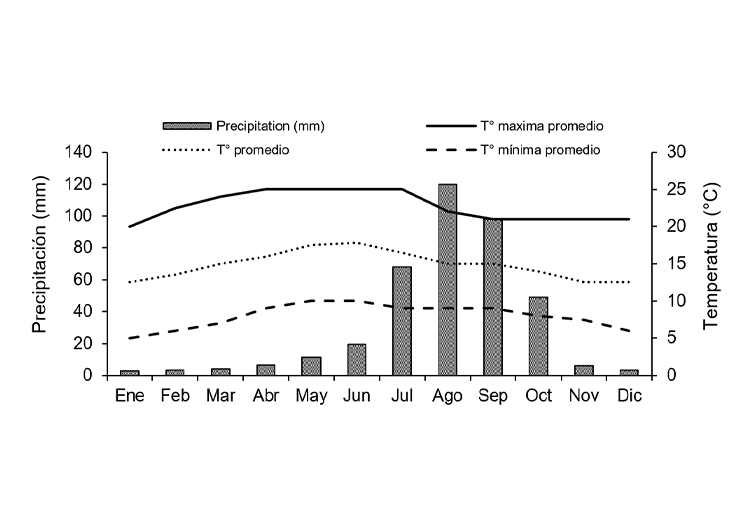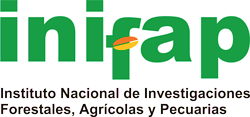Characterization of native corns in Tulancingo, Hidalgo
DOI:
https://doi.org/10.29312/remexca.v16i5.3743Keywords:
Zea mays, Ahuehuetitla, flowering in corn, stepwiseAbstract
Given the need to propagate productive native corns and preserve in situ those from other sites in Mexico, in Tulancingo, Hidalgo, the objective was to assess 23 native Mexican corns in yield, phenology, and characterization of plants and ears of corn in the Highlands of Hidalgo. The sowing was carried out on April 19, 2022, in a completely randomized block design with three replications. Plant height, number of leaves and ears, days to female and male flowering, grain yield, weight of 200 grains, volumetric weight, diameter and length of the ear and number of rows and grains were evaluated. Anova with GLM of SAS and Tukey’s test (α= 0.05) were carried out; likewise, a Pearson regression analysis was performed and the Stepwise option of Sas was used to find out which variable is most responsible for yield. The highest grain yield was observed in the genotype from Atlixco, Puebla (6 782 kg ha-1; p< 0.05). The earliest corn were Huitchila and Palomero, with male flowering 75 and 78 days after sowing (das) and female flowering at 80 and 83 das, respectively (p< 0.05). The 200 heaviest corn grains were from Cuetzala, Guerrero with 94.4 g (p< 0.05), whereas the highest volumetric weight occurred in Palomero, 70.7 kg hl-1. Grain yield was influenced by ear diameter by 28% (p< 0.05). The knowledge of native corns in Tulancingo, Hidalgo, allowed the corn from Atlixco, Romita, Tehuacán, Chaltenco, and Huitchila to be highlighted in terms of grain yield.
Downloads
References
Aguilar-Carpio, C.; Escalante-Estrada, J. A. S.; Aguilar-Mariscal, I. y Rojas-Victoria, N. J. 2022. Rentabilidad y rendimiento de tres genotipos de maíz en respuesta al biofertilizante y nitrógeno, en clima templado. Biotecnia. 24(2):77-83. https://doi.org/10.18633/biotecnia.v24i2.1603.
Álvarez-Vázquez, P.; Rojas-García, A. R.; Joaquin-Cancino, S.; Velázquez-Martínez, M.; Rodríguez-Ortega, L.T. y Hernández-Guzmán, F.J. 2022. Producción de forraje y semilla de ocho pastos al establecimiento en Tulancingo, Hidalgo. Revista Mexicana de Ciencias Agrícolas. 13(6):1041-1053. https://doi.org/10.29312/remexca.v13i6.3027.
Ángeles-Gaspar, E.; Ortiz-Torres, E.; López, P. A. y López-Romero, G. 2010. Caracterización y rendimiento de poblaciones de maíz nativas de Molcaxac, Puebla. Revista Fitotecnia Mexicana. 33(4):287-296. https://doi.org/10.35196/rfm.2010.4.287.
Arellano, V. J. L.; Virgen, V. J. y Rojas, M. I. 2018. Gacela H72: híbrido de maíz precoz para áreas de temporal y riego del Altiplano Central de México. Revista Mexicana de Ciencias Agrícolas. 9(6):1303-1310. https://www.scielo.org.mx/pdf/remexca/v9n6/2007-0934-remexca-9-06-1303.pdf.
Cabrera-Toledo, J. M.; Carballo-Carballo, A.; Mejía-Contreras, J. A.; García-Santos, G. y Vaquera-Huerta, H. 2019. Caracterización de poblaciones sobresalientes de maíz de la raza zapalote chico. Revista Fitotecnia Mexicana. 42(3):269-279. https://doi.org/10.35196/rfm.2019.3.269.
Cruz-Lázaro, E.; Córdova-Orellana, H.; Estrada-Botello, M. A.; Mendoza-Palacios, J. D.; Gómez-Vázquez, A. y Brito-Manzano, N. P. 2009. Rendimiento de grano de genotipos de maíz sembrados bajo tres densidades de población. Universidad y Ciencia. 25(1):93-98. https://www.scielo.org.mx/pdf/uc/v25n1/v25n1a7.pdf.
Espinosa, T. L. C.; Rincón, S. F.; Ruíz, T. N. A.; Martínez, R. J. M. y Benavides, M. A. 2019. Respuesta ambiental de poblaciones nativas de maíz del sureste de Coahuila, México. Nova Scientia. 11(23):108-125. https://www.scielo.org.mx/pdf/ns/v11n23/2007-0705-ns-11-23-00006.pdf.
García, A. E. 2004. Modificaciones al Sistema de Clasificación Climática de Köppen. Instituto de Geografía, Universidad Nacional Autónoma de México. México, DF. 90 p.
González-Martínez, J.; Rocandio-Rodríguez, M.; Contreras-Toledo, A. R.; Joaquín-Cancino, S.; Vanoye-Eligio, V.; Chacón-Hernández, J. C. y Hernández-Bautista, A. 2020. Diversidad morfológica y agronómica de maíces nativos del Altiplano de Tamaulipas. Revista Fitotecnia Mexicana. 4(43):361-370. https://revfitotecnia.mx/index.php/RFM/article/view/811
Hortelano, S. R. M.; Gil, M. A.; Santacruz, V. A.; López, S. H.; Antonio, L. P. y Miranda, C. S. 2012. Diversidad fenotípica de maíces nativos del Altiplano Centro-Oriente del Estado de Puebla, México. Revista Fitotecnia Mexicana. 35(2):97-109. https://revfitotecnia.mx/index.php/RFM/article/view/517.
INEGI. 2017. Instituto Nacional de Estadística y Geografía. Anuario Estadístico y Geográfico de Hidalgo. Instituto Nacional de Estadística y Geografía, Ciudad de México. 671 p.
Perales, H. and Golicher, D. 2014. Mapping the diversity of maize races in Mexico. PLoS ONE. 9(12):e114657. Doi:10.1371/journal.pone.0114657.
Quero-Carrillo, A. R.; Hernández-Guzmán, F. J.; Pérez-Rodríguez, P.; Hernández-Livera, A.; García-Santos, G.; Landa-Salgado, P. y Ramírez-Sánchez, S. E. 2017. Germinación de cariópsides clasificados por tamaño y diásporas de cuatro pastos para temporal semiárido. Revista Mexicana de Ciencias Agrícolas. 40(1):489-502.
Rodríguez-Ortega, L. T.; Landa-Salgado, P.; Velázquez-Martínez, M.; Hernández-Martínez, R.; Mendoza-Pedroza, S. I.; Hernández-Guzmán, F. J.; Hernández-Reséndiz, E. J. 2024. Rendimiento de forraje, grano y calidad de ensilado de maíces híbridos en el Valle de Tulancingo, México. Revista Fitotecnia Mexicana. 47(4):349-358.
Sánchez-Hernández, M. A.; Morales-Terán, G.; Mendoza-Pedroza, S. I.; Hernández-Bautista, J.; Fraire-Cordero, S. y Rivas-Jacobo M. A. 2021. Caracterización de maíces nativos con aptitud forrajera en la Cuenca Baja del Papaloapan. Revista Fitotecnia Mexicana. 44(4A):755-764. https://revfitotecnia.mx/index.php/RFM/article/view/908.
SAS. Instituto. 2010. SAS/STAT User’s Guide Version 9.2. SAS Institute Inc. Cary, North Carolina, USA. 5136 p.
SNICS. 2022. Servicio Nacional de Inspección y Certificación de Semillas. Guía para la descripción de variedades nativas maíz (Zea mays L.). Secretaría de Agricultura y Desarrollo Rural. Ciudad de México. 34 p. https://www.gob.mx/cms/uploads/attachment/file/891830/GuiaMaizNativo2024-final.pdf.
Vega, A. I.; Flores, S. D.; Escalona, M. M. J.; Castillo, G. F. y Jiménez, V. M. A. 2022. Tlaxcala, investigación en maíz nativo y mejorado: problemática, campos del conocimiento y nuevos retos. Revista Mexicana de Ciencias Agrícolas. 13(3):539-551. https://doi.org/10.29312/remexca.v13i3.2888.
Velasco, M. S.; Tadeo, R. M.; Espinosa, C. A.; Zaragoza, E. J.; Canales, I. E. y Coutiño, E. B. 2022. Rendimiento de grano, forraje y calidad forrajera de nuevos híbridos de maíz de Valles Altos. Revista Mexicana de Ciencias Agrícolas 13(1):77-87. https://doi.org/10.29312/remexca.v13i1.2398.
Widholm, J. M.; Kumlehn, J. and Nagata, T. 2014. Biotechnological approaches to barely improvement. Biotechnology in Agriculture and Forestry. Volume 69. Kumlehn, J. and Stein, N. Ed. Springer. Heidelberg. 426 p.

Published
How to Cite
Issue
Section
License
Copyright (c) 2025 Revista Mexicana de Ciencias Agrícolas

This work is licensed under a Creative Commons Attribution-NonCommercial 4.0 International License.
The authors who publish in Revista Mexicana de Ciencias Agrícolas accept the following conditions:
In accordance with copyright laws, Revista Mexicana de Ciencias Agrícolas recognizes and respects the authors’ moral right and ownership of property rights which will be transferred to the journal for dissemination in open access. Invariably, all the authors have to sign a letter of transfer of property rights and of originality of the article to Instituto Nacional de Investigaciones Forestales, Agrícolas y Pecuarias (INIFAP) [National Institute of Forestry, Agricultural and Livestock Research]. The author(s) must pay a fee for the reception of articles before proceeding to editorial review.
All the texts published by Revista Mexicana de Ciencias Agrícolas —with no exception— are distributed under a Creative Commons License Attribution-NonCommercial 4.0 International (CC BY-NC 4.0), which allows third parties to use the publication as long as the work’s authorship and its first publication in this journal are mentioned.
The author(s) can enter into independent and additional contractual agreements for the nonexclusive distribution of the version of the article published in Revista Mexicana de Ciencias Agrícolas (for example include it into an institutional repository or publish it in a book) as long as it is clearly and explicitly indicated that the work was published for the first time in Revista Mexicana de Ciencias Agrícolas.
For all the above, the authors shall send the Letter-transfer of Property Rights for the first publication duly filled in and signed by the author(s). This form must be sent as a PDF file to: revista_atm@yahoo.com.mx; cienciasagricola@inifap.gob.mx; remexca2017@gmail.
This work is licensed under a Creative Commons Attribution-Noncommercial 4.0 International license.


